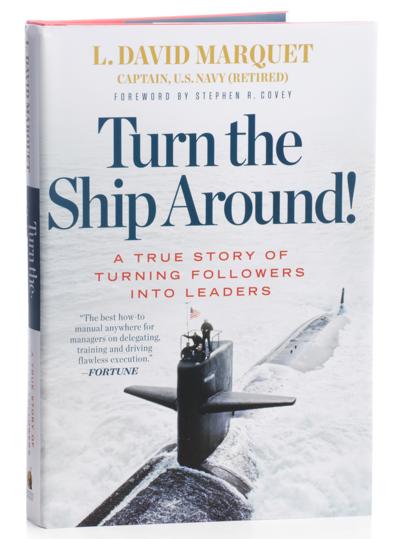Many women are praised for having an intuitive handle on empowering those who work for them. Whether women are naturally good at this skill or not, true empowerment is the most challenging leadership style to master. Last month I read a book, Turn the Ship Around, that I think really nails the leadership skills necessary to do this well and earlier this week I wrote a book review on it for Smartblogs on Leadership. I’m reposting the book review for Turn the Ship Around here because women in leadership need to understand these EMpowerment and INpowerment principles to excel, even if they come by this approach naturally. Leadership is a learned art, regardless of your gender.
Leadership Upside Down: A Book Review of “Turn The Ship Around” by Captain L. David Marquet (Ret.)
Empowerment is bunk. Most people who’re serious about leadership know this, but it’s not because empowerment is a bad idea, it’s because most leaders don’t have the skill and courage to do it right. At its best, when we EMpower a follower, we give them the authoritative space to figure out for themselves that true leadership power comes from the INside, through a transformative and entirely personal process. We provide guidance and allow them to take true responsibility and total ownership. We tolerate deviations from our style in pursuit of solutions we never dreamed were possible. We believe they can do it so they believe they can do it. This requires a lot of wisdom, discipline, patience and courage by the “leader” who creates this special space, within which the EMpowered follower transforms into an INpowered leader.
Empowering leadership is more art than science. By definition, we’re sending our troops into the black box of their own soul where we have no control. The essence of empowerment is that you hand control to them and see what they can do with it. When it works, they boost performance with their creativity, drive and innovation. But of course, sometimes they don’t. Leading this way is impossible for control freaks, and nerve-wracking for everyone else, because we may end up presiding over a total performance nose dive, lost profits or angry customers. True empowerment, that leads to inpowered success, is not bunk, but it is a risk. Can you imagine doing this in your company?
Now imagine doing this on a nuclear submarine, where such a failed experiment could send hundreds of millions (billions?) of dollars of U.S. Navy property and priceless human lives to the bottom of the ocean. Would you take an empowerment risk if you were in charge of that ship? Capt. L. David Marquet did and ten years later when it became clear that his approach had lasting positive impacts, he wrote a book about it.
Capt. Marquet, a Navy trained command-and-control leader, had this experiment practically thrust upon him when he was assigned to a ship he hadn’t expected to command, the USS Santa Fe, after training for 12 months to run the USS Olympia. Oops. Best laid plans and all that… Arriving on a new ship that he knew nothing about, he was wise enough to realize that empowering the crew – who did know the ship intimately – was the only way to go. It was an experiment that could have gone so very wrong, but thanks to the fact that Capt. Marquet did the hard work to figure out how to implement empowerment correctly, his ship and crew transformed from the worst-rated sub into the first-rated sub – in a year.
The Hunt for Red October Meets Harvard Business School
I’m not going to tell you more of Capt. Marquet’s story because I really want you to buy the book, Turn The Ship Around, and read it. It’s a fast and powerful read and you’ll want to read it more than once. Stephen Covey wrote the forward and one of the reviewers describes it as, “the Hunt for Red October meets Harvard Business School,” and he’s right.
You’ll enjoy the book, but here’s why it’s not just another book about leadership and empowerment. Marquet applies a military practitioner’s attention to detail and actually begins to decode the genome for the art of empowering leadership. He gives those brave leaders pursuing true empowerment some blueprints for building a black box to send their empowered leaders into, where they can discover their own inner power to lead.
For example, many leadership gurus talk about how important it is for empowered employees to be given visionary direction. Marquet calls this effort “Clarity” and breaks it down into 7 specific principles, including some we’ve heard before like striving for excellence, building trust and beginning with the end in mind. But he goes deeper and also identifies subtle but powerful distinctions between questioning and curiosity; he demonstrates what it looks like to use guiding principles in decision-making instead of slapping a vision on the wall and hoping people will figure it out.
A New Chapter In The Leadership Guru Book On Empowerment
Despite these great insights, however, I believe that Marquet has added a new chapter to the guru book on empowering leadership by identifying a key reason so many empowerment efforts fail. Marquet exposes, through principle and anecdote, the critical dependency between giving up leadership control and investing in giving your newly empowered leaders their own control mechanisms and technical competence. During one of the inspections where the Santa Fe received high marks, an inspector noted that the Santa Fe crew “tried to make as many mistakes” as other crews, but the control mechanisms they used to catch themselves and each other overrode the foul-ups before they could execute the errors. Similarly, through trial and error, Capt. Marquet discovered that giving people control without also giving them the technical knowledge to succeed was a recipe for disaster. By dissecting the Sante Fe’s experience, he breaks out the 8 principles of empowering “Control” and the 5 principles of “Competence.”
He also illuminates employees’ inherent desire to contribute to a successful organization when their own gifts and abilities are honored and trusted. My favorite anecdote from the book is the way that he outlawed chasing down noises in the ship (e.g., dropping a wrench) and “reporting” the noisy crew members for threatening to expose the Santa Fe to enemy subs’ sonar. Instead, he asked crew members to self-report when they made noises and before he knew it, more noises were being reported than sonar could detect AND the overall number of noise-makings went down. This might not have happened on another ship, but Marquet and the officers who conspired to revolutionize the command-and-control leadership model of the U.S. Navy did one very important thing; they did not reprimand noise-makers for self-reporting.
Remove the fear factor, reward responsibility and people will begin to see the benefits in accepting true ownership of their work.
The lesson here, which I believe is so important and which Turn the Ship Around makes so very clear, is that empowering leadership doesn’t work if you’re not willing to invest in your people and believe they can achieve greatness. Giving up control doesn’t mean giving up standards of excellence. In fact, the opposite is true. Standards of excellence become your primary control mechanism, and belief in your teams’ ability to accomplish them becomes your primary leadership power. If your people don’t have the knowledge and belief in themselves necessary to achieve excellence, the experiment’s not going to work and you can all too easily talk yourself back into the “do I have to do everything around here?” mentality that keeps so many organizations limited to the capacity and talent of their top management team.
Join The Movement?
David Marquet has coined the term “leader-leader” to describe this approach to empowering leadership that helps develop and grow inpowered leaders. I had the pleasure of meeting him personally and know that he believes in his bones that any approach except leader-leader will fail to achieve excellence in our increasingly complex world. He also knows that it’s going to take a movement to keep practicing and exploring these principles (including discovering more) until we all understand their true potential and every leader gets trained to implement them. He’s started the movement to apply these principles in business and I’m on board. How about you?
Follow David Marquet on Twitter at @LDavidMarquet and LinkedIn.
This post originally appeared on SmartBlog on Leadership. For more insights on business leadership, sign up for SmartBrief on Leadership.
Check out the resources in the InPower Coaching EQ at Work and Soft Skills Research Index.
Personal Brand Coaching
Free Webinar
How do you attract opportunities to you before you have to go looking for them? The solution is simple–
find meaning in your work, target your next opportunity with intention and
share your “true you” personal brand story with everyone you meet!
We’ll show you how.







